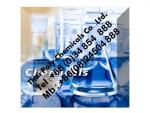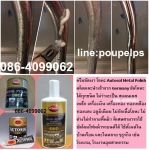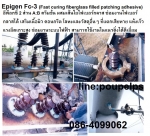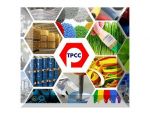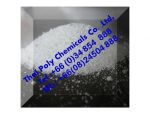เมทิลแอลกอฮอล์, เมทานอล, Methyl alcohol, Methanol, เมธิลแอลกอฮอล์, CH3OH |
฿1 |
|
ชื่อผู้ประกาศ : ไทยโพลีเคมิคอล เบอร์โทรศัพท์ : 034854888, 034496284 โทรศัพท์มือถือ : 0800160016 ที่อยู่ : 36/5 ม.9 ต.นาดี อ.เมืองสมุทรสาคร จ.สมุทรสาคร 74000 ร้าน Thai Poly Chemicals |
นำเข้าและจำหน่าย เมทิลแอลกอฮอล์,
เมทานอล, Methyl alcohol, Methanol, เมธิลแอลกอฮอล์, CH3OH สอบถามข้อมูลเพิ่มเติมได้ที่ ฝ่ายขาย บริษัท ไทยโพลีเคมิคอล จำกัด โทรศัพท์
034854888, 034496284 มือถือ 0824504888, 0800160016 โทรสาร 034854899, 034496285
เมทานอล, Methanol, เมทิลแอลกอฮอล์, Methyl
Alcohol, MeOH
เมทานอล (อังกฤษ: methanol) หรือ เมทิลแอลกอฮอล์
(อังกฤษ: methyl alcohol) มีสูตรโครงสร้างแบบย่อ CH3OH
เป็นของเหลวใส ระเหยง่าย เป็นพิษ นิยมใช้เป็นตัวทำละลาย
และใช้เป็นเชื้อเพลิง ในธรรมชาติ เมทานอลเป็นผลิตภัณฑ์จากการสลายสารอาหารแบบไม่ใช้ออกซิเจนของแบคทีเรียหลายชนิด (ดูการผลิตเมทานอลจากของเสียเพื่อทำเป็นก๊าซชีวภาพ)
หากเราเผาเมทานอลกับอากาศ
จะได้คาร์บอนไดออกไซด์กับน้ำ ดังสมการด้านล่างนี้ 2 CH3OH + 3 O2 ? 2 CO2 + 4 H2O
ซึ่งเปลวไฟที่ได้จากการเผาเกือบจะมองไม่เห็นเลย
ดังนั้นจึงควรระมัดระวังหากมีการใช้เมทานอลเป็นเชื้อเพลิง
นอกจากนี้เมทานอลยังใช้ผสมเอทานอล เพื่อมิให้สามารถรับประทานได้ (denatured alcohol) ทั้งนี้เพื่อประโยชน์ในทางภาษีอากรMethanol, also known as methyl
alcohol, wood alcohol, wood naphtha or wood spirits, is a chemical with the
formula CH3OH (often abbreviated MeOH). Methanol acquiredthe name "wood alcohol" because it was once produced chiefly as a
byproduct of the destructive distillation of wood. Modern methanol is produced
in a catalytic industrial process directly from carbon monoxide, carbon
dioxide, and hydrogen.Methanol is the simplest alcohol,
and is a light, volatile, colorless, flammable liquid with a distinctive odor
very similar to, but slightly sweeter than, that of ethanol (drinking
alcohol).[5] At room temperature, it is a polar liquid,and is used as an antifreeze, solvent, fuel, and as a denaturant for ethanol.
It is also used for producing biodiesel via transesterification reaction.Methanol is produced naturally in
the anaerobic metabolism of many varieties of bacteria, and is commonly present
in small amounts in the environment. As a result, there is a small fraction of
methanol vapor in the atmosphere. Over the course of several days, atmospheric
methanol is oxidized with the help of sunlight to carbon dioxide and water.Methanol burns in oxygen including
open air, forming carbon dioxide and water: 2 CH3OH + 3 O2 ? 2 CO2 + 4
H2O
Methanol ingested in large
quantities is metabolized to formic acid or formate salts, which is poisonous
to the central nervous system, and may cause blindness, coma, and death.
Because of these toxic properties, methanol is frequently used as a denaturant
additive for ethanol manufactured for industrial uses. This addition of
methanol exempts industrial ethanol (commonly known as "denatured
alcohol" or "methylated spirit") from liquor excise taxation in
the US and some other countries.Applications
Methanol, a common laboratory
solvent, is especially useful for HPLC, UV/VIS spectroscopy, and LCMS due to
its low UV cutoff.Feedstock
The largest use of methanol by far
is in making other chemicals. About 40% of methanol isconverted to formaldehyde, and from there into products as diverse as plastics,
plywood, paints, explosives, and permanent press textiles.Also in the early 1970s,
a methanol to gasoline process was developed by Mobil for producing gasoline ready for use in vehicles. One such industrial facility was built at Motunui in large amounts of methanol were used in the United States to produce the gasoline additive methyl tert-butyl ether (MTBE). While MTBE is no longer marketed in the U.S., it is still widely used in other parts of the world. In addition to direct use as a fuel, methanol (or less commonly, ethanol) is used as a component in the transesterification of triglycerides to yield a form of
Other chemical derivatives of
methanol include dimethyl ether, which has replaced chlorofluorocarbons as an
aerosol spray propellant, and acetic acid. Dimethyl ether (DME) also can be
blended with liquified petroleum gas (LPG) for home heating and cooking, and
can be used as a diesel replacement for transportation fuel.Methanol-to-Olefins/Methanol-to-Propylene
(MTO/MTP), among others processes such as: Metathesis, Propane Dehydrogenation
(PDH), High Severity FCC, and Olefins Cracking, is a new and novel lower-cost
chemical process for on-purpose propylene production technology of high
interest to the petrochemical marketplace, to supply the tight propylene
market.The market became tight because of
the ethane prices falling in the USA, due to the exploration of shale gas
reserves. The low price ethylene produced from this raw material has given
chemical producers in North America a feedstock advantage. Such change has put
naphtha-fed steam crackers at a disadvantageous position, with many of them
shutting down or revamping to use ethane as feedstock. Nevertheless, the
propylene output rates from ethane-fed crackers are negligible.Fuel for vehicles
Main articles: Methanol fuel and
methanol economyMethanol is used on a limited
basis to fuel internal combustion engines. Pure methanol is required by rule to
be used in Champcars, Monster Trucks, USAC sprint cars (as well as midgets,
modifieds, etc.), and other dirt track series, such as World of Outlaws, and
Motorcycle Speedway. Methanol is also used, as the primary fuel ingredient
since the late 1940s, in the powerplants for radiocontrol, control line and free flight airplanes (as methanol is required in the
engines that primarily power them), cars and trucks, from such an engine's use
of a platinum filament glow plug being able to ignite the methanol vapor through
a catalytic reaction. Drag racers and mud racers, as well as heavily modified
tractor pullers, also use methanol as their primary fuel source. Methanol is
required with a supercharged engine in a Top Alcohol Dragster and, until the
end of the 2006 season, all vehicles in the Indianapolis 500 had to run methanol. Mud racers have mixed methanol withgasoline with nitrous oxide to produce more power than mixing gasoline and
nitrous oxide alone.One of the potential drawbacks of
using high concentrations of methanol (and other alcohols, such as ethanol) in fuel is the corrosivity to some metals of methanol, particularly to aluminium. Methanol, although a weak acid, attacks the oxide coating that normally
6 CH3OH + Al2O3 ? 2 Al(OCH3)3
+ 3 H2O
The resulting methoxide salts are
soluble in methanol, resulting in a clean aluminium surface, which is readily
oxidized by dissolved oxygen. Also, the methanol can act as an oxidizer: 6 CH3OH + 2 Al ? 2 Al(OCH3)3
+ 3 H2
This reciprocal process
effectively fuels corrosion until either the metal is eaten away or the
concentration of CH3OH is negligible. Concerns withmethanol's corrosivity have been addressed by using methanol-compatible
materials, and fuel additives that serve as corrosion inhibitors.When produced from wood or other
organic materials, the resulting organic methanol (bioalcohol) has been
suggested as renewable alternative to petroleum-based hydrocarbons. Low levels
of methanol can be used in existing vehicles, with the use of proper cosolvents
and corrosion inhibitors.Methanol fuel has been proposed
for ground transportation. The chief advantage of a methanol economy is that it
could be adapted to present internal combustion engines with a minimum of
modification in both engines and infrastructure to store and deliver liquid
fuel.Government policy
The European Fuel Quality Directive
allows up to 3% methanol with an equal amount of cosolventto be blending in gasoline sold in Europe. China uses more than one billion
gallons of methanol per year as a transportation fuel in both low level blends
used in existing vehicles, and as high level blends in vehicles designed to
accommodate the use of methanol fuels.In the USA in 2011,
the Open Fuel Standard Act of 2011 was introduced in the
US Congress to encourage car manufacturers to warrant their cars to burn methanol as a fuel in addition to gasoline and ethanol. The bill is being
Other applications
Methanol is a traditional
denaturant for ethanol, the product being known as "denatured
alcohol" or "methylated spirit". This was commonly used during
the Prohibition to discourage consumption of bootlegged liquor, and ended up
causing several deaths.Methanol is also used as a
solvent, and as an antifreeze in pipelines and windshield washer fluid.In some wastewater treatment
plants, a small amount of methanol is added to wastewater to provide a carbon
food source for the denitrifying bacteria, which convert nitrates to nitrogen
to reduce the nitrification of sensitive aquifers.During World War II, methanol was
used as a fuel in several German military rocket designs, under the name
M-Stoff, and in a roughly 50/50 mixture with hydrazine, known as C-Stoff.Methanol was used as an automobile coolant antifreeze in the early 1900s.
Methanol is used as a denaturing
agent in polyacrylamide gel electrophoresis.Direct-methanol fuel cells are
unique in their low temperature, atmospheric pressure operation, allowing them
to be miniaturized to an unprecedented degree. This, combined with the
relatively easy and safe storage and handling of methanol, may open the
possibility of fuel cell-powered consumer electronics, such as for laptop
computers and mobile phones.Methanol is also a widely used
fuel in camping and boating stoves. Methanol burns well in an unpressurized
burner, so alcohol stoves are often very simple, sometimes little more than a
cup to hold fuel. This lack of complexity makes them a favorite of hikers who
spend extended time in the wilderness. Similarly, the alcohol can also be
gelled to reduce risk of leaking or spilling, as with the brand
"Sterno".Methanol is mixed with water and
injected into high performance diesel and gasoline engines for an increase of
power and a decrease in intake air temperature in a process known as water
methanol injection.Energy carrier
Methanol is also useful as an
energy carrier. It is easier to store than hydrogen, burns cleaner than fossil
fuels, and is biodegradable
สอบถามข้อมูลเพิ่มเติมได้ที่
ฝ่ายขายThai Poly Chemicals Co., Ltd.
บริษัท ไทยโพลีเคมิคอล จำกัด
ที่อยู่36/5 ม.9 แขวง/ตำบลนาดี เขต/อำเภอเมืองสมุทรสาคร จังหวัดสมุทรสาคร รหัสไปรษณีย์74000
Tel.: 034854888,
034496284
Fax.: 034854899,
034496285
Mobile: 0824504888,
0800160016
Website :
www.thaipolychemicals.comEmail1 : thaipolychemicals@hotmail.com
Email2 : info@thaipolychemicals.com
alcoholMethylเมทานอลCH3OHเมทิลแอลกอฮอล์Methanolเมธิลแอลกอฮอล์

